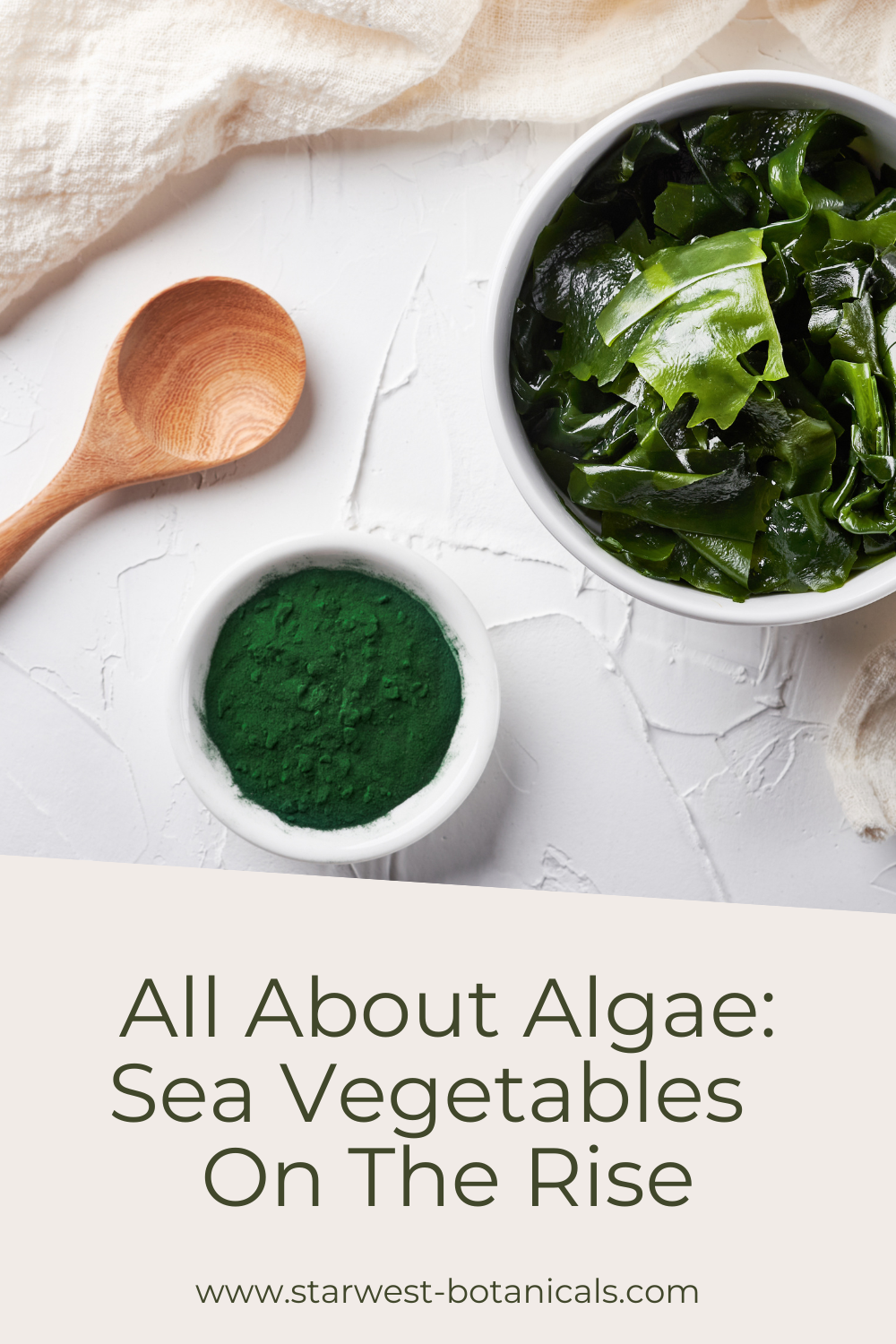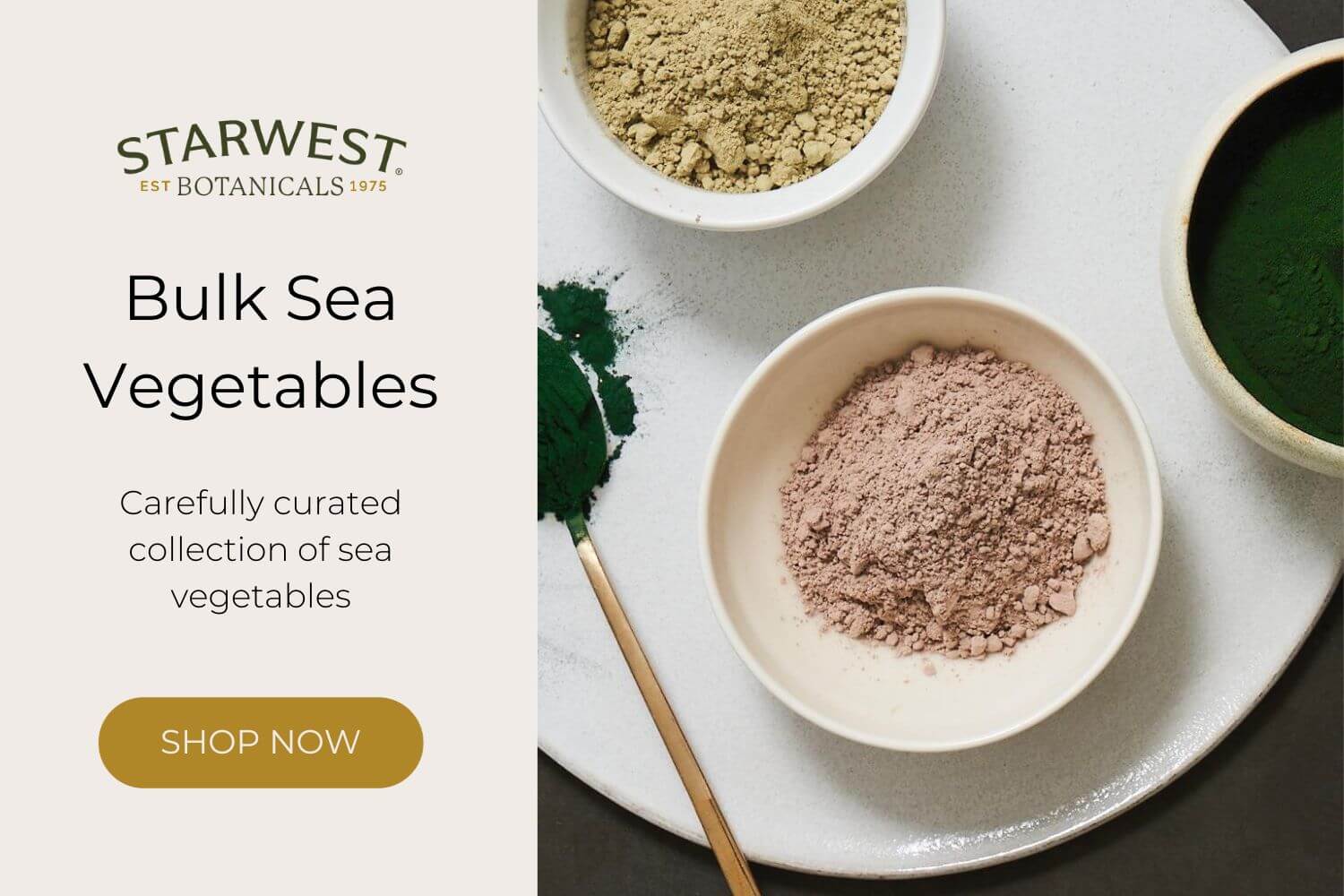All About Algae: Sea Vegetables On The Rise
Posted by Starwest Botanicals on 08-09-2023

Sea vegetables algae and seaweed are low calorie, nutrient-packed, and sustainable—a trifecta that is bolstering this trending subset of superfoods. They are full of vitamins and minerals including potassium, calcium, magnesium, and iron.
Nutritional benefits paired with consumer awareness about sea vegetables’ mitigation of climate change has led to more than 63% growth in the seaweed category alone in the last five years.
Algae & Seaweed: What’s The Difference?
Red and brown algae are found in the ocean, while green algae are common in freshwater and on land. Algae can grow in both deep and shallow water. These plant like organisms attach themselves to rocks and other hard surfaces. Seaweed is simply a type of algae only found in the ocean. Seaweed only grows in shallow water.
Here, we dive deep into seven on-trend algae we carry at Starwest.
We’ll explore seaweeds, Irish moss, agar agar, kelp, bladderwrack, and dulse leaf; as well as algae varieties spirulina (found in both freshwater and saltwater) and chlorella (only found in freshwater).
Used in both culinary and wellness applications, we’re seeing sea vegetables show up in everything from pasta to face masks. With more consumers seeking vegan and vegetarian alternatives, vegan “seafood” dishes and gelatin replacements are being created from sea vegetables.
Sustainable Sea Vegetables
Sea vegetables have a positive environmental impact due to a variety of factors. Whether farmed or harvested, most sea greens are grown in the ocean and don’t require feed, freshwater, or fertilizer; making them one of the most sustainable forms of agriculture on the planet.
Seaweeds in particular are one of the fastest growing plants on earth. They absorb significant amounts of carbon dioxide, nitrogen, and phos phorus; helping clean up our oceans. Seaweed farms also provide a habitat for marine life and help protect and balance ecosystems.
Farming seaweed has the potential to sustainably feed both humans and animals, and expand fuel production. Large ocean farms could be the solution to address food insecurity, mitigate climate change, and move away from land-based agriculture, freeing up land for other uses.
Replacing just 10% of human diets globally with seaweed products would prevent the farming of 110 million hectares of land.
Ph.D. Candidate Scott Spillias from UQ’s School of Earth and Environmental Science states:
“Our study found that expanding seaweed farming could help reduce demand for terrestrial crops and reduce global agricultural greenhouse gas emissions(GHG) by up to 2.6 billion tons of CO2-equivalent per year.”
7 Trending Sea Vegetables
Irish Moss
Irish moss, or sea moss, is a species of red algae that grows along the Atlantic coast across the British Isles, continental Europe, and North America. This small, frilly seaweed resembles frisée lettuce.
Irish moss’ main component is carrageenan, a gelatinous substance often used as a thickener in dairy and meat products as well as cosmetics and medications.
This trending sea vegetable has surged in popularity after receiving a number of celebrity endorsements during the past few years.
While specific health claims haven’t been proven, like all trendy superfoods, sea moss does boast health benefits. It’s rich in antioxidants and contains a lot of potassium, making it a low-calorie way to add nutrients to your diet. Some studies about seaweed in general have suggested that the omega-3 fatty acids and vitamins D and B12 it contains may help support the immune system.*
Sea moss is commonly found in supplements including capsules, gummies, and powders. Sea moss also appears as the main ingredient in a myriad of skincare products.
This sea moss gel from Herbal Vineyards is just one example of sea moss marketed as a superfood.
Other names for Irish moss may include carragheen, carrageenan, or sea moss.
Agar Agar
Agar agar powder is a jellylike substance derived from red algae, a type of seaweed. It can be used as a stabilizer or thickening agent. Its uses range from a vegetarian substitute for gelatin to a clarifying agent in brewing, and even as a filler in paper and fabric.
Agar agar is growing in popularity as a vegetarian and vegan alternative to animal derived gelatin that is found in so many desserts and candies. It’s perfect for puddings, mousses, jellies, ice cream, and gummy candies—practically anywhere gelatin is used.
Outside of food applications, agar agar is a common ingredient in beauty and wellness products.
This eye mask from Haeckels contains Agar agar as the main ingredient.
Agar agar is sometimes called agar weed, red algae, China glass, Japanese kanten, or simply agar.
Kelp
Kelp are large brown algae seaweeds that live in cool, shallow waters close to shore.
Even five years ago Food Ingredients First proposed kelp might be the new kale. Then, sea greens were mainly limited to wellness and beauty products and in the restaurant sector.
Now, “Help From Kelp” is one of Whole Foods’ Top 10 Food Trends for 2023: “In its original form, kelp can absorb carbon in the atmosphere, making kelp farming more important than ever in the age of climate consciousness. Kelp grows quickly, doesn’t require freshwater or added nutrients, and is nutritious and versatile…”
This versatile ingredient has been seen everywhere from noodles to chips, in sauces, and more.
Kelp is especially popular as a vegan alternative to fish sauces due to its ocean like taste. It also makes a great replacement for salt.
Kelp noodles from Sea Tangle is just one example of kelp in a food application. They are marketed specifically to health conscious consumers as a limited ingredient, gluten-free, and low carb product.
This product line also has varieties featuring green tea and moringa for even more botanical benefits.
At Starwest, we stock kelp in granule and powder form.
Bladderwrack
Bladderwrack is a type of brown seaweed grown along the coastlines of the Atlantic and Pacific Oceans and the North and Baltic Seas. The whole plant has been used in traditional medicine for centuries. Bladderwrack powder is rich in fiber, calcium, magnesium, potassium, zinc, and vitamins A and C.
Culinarily, bladderwrack has a strong aroma and is perfect for soups and spice blends, or steep it as a tea. Bladderwrack is almost exclusively found in herbal supplements such as tinctures, powders, and capsules.
Nature’s Way Bladderwrack with Iodine supplement is marketed as an iodine supplement to “help maintain normal production of thyroid hormones and normal thyroid function”.
Bladderwrack is sometimes called Fucus vesiculosus, rockweed, and red fucus.
Dulse Leaf
Dulse leaf is a reddish-purple seaweed that is found along the Atlantic and Pacific coasts. Dulse contains significant amounts of calcium, potassium, and vitamin B12.*
With its mildly salty, savory, and smoky umami flavor, dulce is often compared to the taste of bacon. Sprinkle the powder over popcorn and scrambled eggs or mix it into homemade vinaigrettes.
Dee’s Vegan Sausages with Irish Dulse Seaweed is one example of dulse leaf we’ve found in packaged foods.
Common names for Dulse Leaf include dillisk, water leaf, and red algae.
Spirulina
Spirulina is a type of blue-green algae that grows in saltwater and freshwater. It’s cultivated worldwide, and we carry spirulina in powder form that is sourced from China, the U.S., and India.
This bright, blue-green algae is a renowned superfood of the sea. Spirulina is about 60% protein, or four grams per tablespoon—one of the highest protein contents per gram of anything on earth, about three times that of beef or lentils. It has been used as a main source of protein in Mexico and parts of Africa for centuries. Spirulina also delivers a high concentration of gamma linolenic acid, an omega-6 fatty acid known for giving skin a gorgeous glow.*
Spirulina has a strong, earthy taste, but it mixes well in smoothies—especially when combined with sweet fruits. It can also be used as a natural food coloring.
While spirulina is most often found in supplements—both capsules and
powders—we’re seeing it in drinks,
snacks, and confections.
Vosges’ Matcha Green Tea & Spirulina Super Dark Chocolate Bar combines spirulina with matcha, another on-trend botanical.
Common names for spirulina include blue green algae and Arthrospira platensis.
Chlorella
Though not technically a “sea vegetable” since it only grows in freshwater, chlorella is a type of algae growing in popularity due to its nutritional benefits. It gets its vibrant green color from a high concentration of the antioxidant chlorophyll. Chlorella is also high in protein, at 50%.
Blend chlorella into a smoothie or add a bit of the powder to vinaigrette salad dressings or pesto. You can also try baking it into cookies or muffins for a fun green hue and a healthy twist. Similar to spirulina, chlorella is most commonly found in supplement capsules and powders. One example of chlorella used in a beauty product is Mara’s Sea Vitamin C Serum With Chlorella andReishi combines chlorella with another trending botanical—reishi mushroom.
Another name for chlorella is cracked cell wall (Chlorella pyrenoidosa). New Explorations With Algae
When it comes to food applications, explore seaweed and algae as a way to introduce new flavors, nutritional benefits, and colors. For vegan and vegetarian alternatives, look no further than sea vegetables to replace gelatin and ingredients in fish-derived sauces.
*Information and statements have not been evaluated by the Food and Drug Adminis tration and are not intended to diagnose, treat, cure, or prevent any disease. You should not use the information contained herein for diagnosing or treating a health problem or disease, or for prescribing any medication. We recommend that you consult with a qualified healthcare practitioner before using any herbal products, particularly if you are pregnant, nursing, or on any medications.



